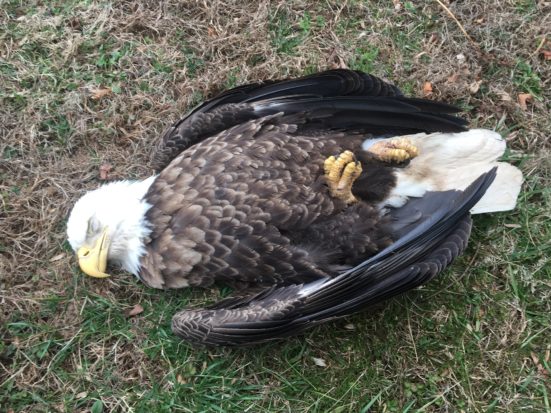
Gulliver, pictured above, was suffering from acute lead poisoning when he was found. He survived, but so many other birds suffer from lead poisoning, and their plight may never be discovered.
Iconic symbols of the United States and also one of the first animals to be protected under the Endangered Species Act, bald eagles are dying in alarming numbers, according to an HSUS survey of news reports. The analysis reveals that lead poisoning has afflicted more than 70 bald eagles in the last year. These, of course, are just the confirmed victims, and the actual number of eagles impaired or killed by lead may be many multiples higher.
But raw numbers don’t tell the story of the kind of suffering that eagles endure from lead poisoning. Earlier this year, I told you about one such bird, Gulliver. Gulliver was suffering from acute lead poisoning when he was found, and would likely not have made it through another day without treatment. He survived, but so many other birds suffer from lead poisoning, and their plight may never be discovered.
Ten years ago this August, the federal government removed this majestic avian predator from the list of endangered and threatened species, after a long and welcome increase in its numbers, from just more than 400 nesting pairs in 1963 to 10,000 in 2006.
While a ban on the use of DDT in the early 1970s provides a big explanation for the recovery, the birds are facing poisoning from countless tons of lead left behind by hunters and fishermen. Spent lead ammunition and discarded or detached fishing gear is the source of the problem.
The toxicological effects of lead on bald eagles and other birds are a settled scientific question. Poisoned birds suffer from weakness, blindness, paralysis of the lungs and the intestinal tract, organ failure, seizures, and death. The news stories we’ve tracked noted that the individual eagles could not stand or fly, were blind, were underweight, had a drooping head or wings, had labored breathing, were run into by vehicles, or were found dead.
Bald eagles ingest lead when they scavenge on tainted gut piles hunters leave behind, or the carcasses of animals that hunters shot but failed to recover. More than 80 percent of the news stories reporting the lead poisoning of bald eagles since the 2007 delisting were first published in the months of November through April, reflecting that these cases spike in the wake of hunting seasons.
Hunters and anglers who switch to non-lead ammunition and tackle can mitigate this problem in dramatic ways. These forms of ammunition and tackle are available in the marketplace, are affordable, and perform just as well in terms of their ballistics.
Just as it alerted us to the presence of DDT in our environment, the bald eagle is our canary in the coal mine when it comes to lead in hunting ammunition and fishing tackle. But it is only one of more than 130 species adversely affected by the lead that’s been widely dispersed in the environment by field sport enthusiasts. The total annual toll of wildlife may be between 10 and 20 million wild animals. How much more evidence do we need to make the switch to less toxic or non-toxic metals?
Regrettably, Interior Secretary Ryan Zinke reversed on his first day in office a U.S. Fish and Wildlife Service directive to phase out lead ammunition on millions of acres of national wildlife refuges. And now Congress seems intent on preventing the EPA from ever wading into the lead debate. Specifically, the Senate Environment and Public Works Committee last week included a provision in the inappropriately named HELP for Wildlife Act to prevent that agency from restricting the use of lead in fishing tackle.
There’s no reason to haggle over or to delay a policy to prevent more lead from being dumped into the environment. One of the strengths of the Endangered Species Act is that it represents our collective resolve to protect wildlife for its own sake. On this 10th anniversary of the delisting of the bald eagle, we should rededicate ourselves to ending the rampant and random poisoning of these remarkable, large-bodied raptors.
The post The HSUS reports that bald eagles can’t soar with lead weighing them down appeared first on A Humane Nation.
Enviroshop is maintained by dedicated NetSys Interactive Inc. owners & employees who generously contribute their time to maintenance & editing, web design, custom programming, & website hosting for Enviroshop.
